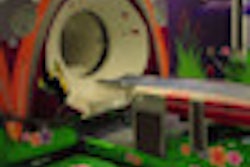CHICAGO - Even in women, who face higher risks of cancer than men from chest CT scans, the risk of lung cancer far outweighs that of breast cancer, according to researchers from the Medical University of South Carolina (MUSC) in Charleston.
Women's cancer risk from chest CT scans was more than twice that of men, the group reported at the 2010 RSNA meeting, but breast cancer accounted for no more than a third of the risk.
CT scans of the chest have several well-known clinical benefits, including the diagnosis of lung disease, malignancies, occult infection, and more, but the risk of cancer induction from the scans is not negligible, and the precise risk to organs has not been well-studied, said Gayatri Joshi, MD.
"This study's purpose was to quantify the risk of noncontrast chest CT, and, specifically, to look at how much radiation we use, how much does the patient absorb, and what is the risk," she said in her RSNA presentation.
Joshi and her colleagues James Ravenel, MD, and Walter Huda, PhD, enrolled 87 consecutive subjects (44 men, 43 women; ages 20-80 years; mean, 62.8 years) who underwent routine noncontrast thoracic CT for a variety of indications. They collected information on patient age and gender, anteroposterior (AP) diameter, scan length, CT dose index volume (CTDIvol) in mGy, and dose-length product (DLP) in mGy-cm.
"The AP was measured at the lowest point in the sternum, where all four [heart] chambers could be visualized," Joshi said. "We wanted a measurement that had the greatest definition for the chest but still wasn't the chest." The sternum is a good AP measurement point because it is still appropriate for patients who have had surgery affecting abdominal organs, she added.
Patients were scanned on one of five different 16- or 64-detector-row scanners, with a maximum 1.25-mm collimation. They then used the ImPACT CT Patient Dosimetry Calculator (version 1.0; 28/08/09) to compute organs doses, which are proportional to CTDIvol.
Joshi and colleagues calculated organ doses for breast, lung, bone marrow, thyroid, stomach, and liver in each individual based on a standard (70-kg) phantom for a 36-cm scan length, and adjusted the numbers for patient size in AP. Finally, they converted the organ doses to organ risk values using patient age- and gender-specific data published in the BEIR VII report on radiation risk. Adding up the risk from all of the organs, they calculated the total patient cancer induction risk.
Automated exposure control (AEC) on the facility's scanners results in higher doses being given to larger patients, but there was really no difference between men and women in terms of total radiation dose, she said. CTDIvol ranged from 10 mGy for small patients (18-cm thickness) to 18 mGy for larger patients (30-cm AP thickness), Joshi reported. Average lung doses were 18 mGy, and the numbers were more or less independent of patient size and age.
"When we looked at actual organ doses, we found there was very little difference between males and females," she said. "There was a little scatter, but absorbed dose to the lungs was nearly constant at about 18 mGy, on average," she said.
The cancer risk in radiosensitive organs was 30 per 100,000 patient examinations, but, on average, the risk in women was 2.2 times higher than in men, she said. In women, increasing patient age from 30 to 80 years reduced the cancer risk by a factor of 12, while the corresponding reduction in male risk was a factor of five, Joshi said.
Cancer risk for men and women from thoracic CT scans*
|
|||||||||||||||
| *Cancer induction risk per 100,000 patients |
Lung cancer was the most important contributor to patient risk, accounting for up to 65% of the total risk in males, and up to 80% of the total risk in females. In women, breast cancer accounted for up to 35% of the total risk. The authors also estimated that organs excluded in the study account for no more than 20% of the total cancer risk in chest CT examinations. The overall median cancer risk per 100,000 individuals scanned was 20 for men and 45.3 for women, Joshi said.
"Specifically, the lung contributed about 75% toward that cancer risk in males, on average, and in women, lung cancer contributed about 65% of the overall risk," she said. "We did see that in young females, particularly in their 30s, up to 35% of the risk is in the breast," she said. "People talk about the breasts being extremely radiosensitive -- and they are -- but in our study we found that still the main contributor to cancer risk is to the lung during chest CT."
Using automatic exposure control, larger patients are exposed to more radiation; however, the lung dose is relatively independent of patient size at about 18 mGy, she said. But the associated cancer risks were very much associated with patient gender and age.
"The take-home message is that the main cancer risk for both males and females is in the lung," Joshi said. It's an important factor to keep in mind when creating a risk-benefit analysis to determine if a chest CT scan is necessary, she said.
By Eric Barnes
AuntMinnie.com staff writer
December 2, 2010
Related Reading
Cancer risk from CT lower than previously reported, December 2, 2010
Radiologists expand proactive dose safety efforts, December 2, 2010
U.S. radiation concerns overdue: Siemens executive, November 29, 2010
Young women have highest cancer risk from body CT scans, July 20, 2010
Studies spotlight high CT radiation dose, increased cancer risk, December 14, 2009
Copyright © 2010 AuntMinnie.com



















